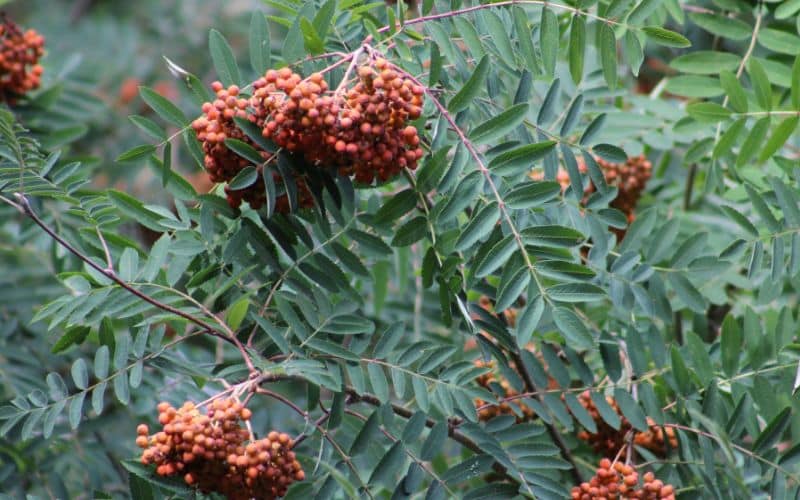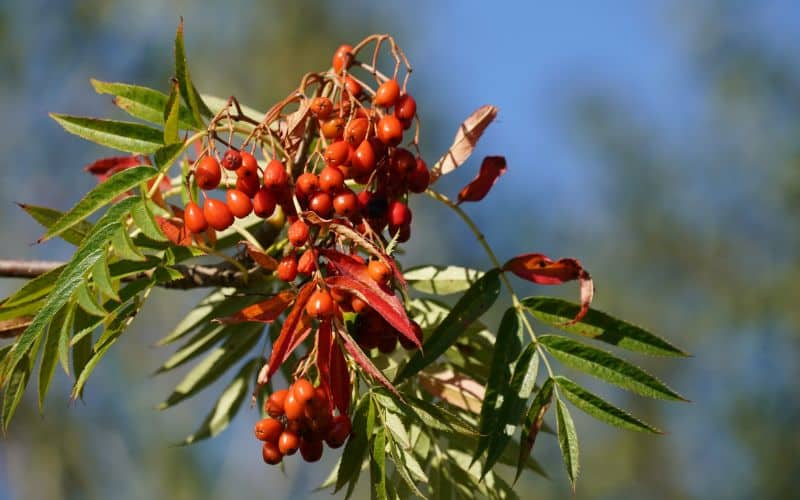
Ontario, home to a wide variety of flora, is particularly renowned for its Mountain Ash trees. Thriving in the province’s unique climate and soil conditions, these deciduous perennials are more than just an attractive addition to your landscape. They’re part of Ontario’s rich biodiversity tapestry.
You’ll often spot Mountain Ash trees adorning urban parks or rural areas with their bright red-orange berries. Beyond their aesthetic appeal, they serve an ecological purpose too – providing food for birds and other wildlife during the harsh winter months. In fact, it’s this balance between beauty and function that makes them such a fascinating species.
Yet there’s so much more to learn about Mountain Ash trees in Ontario than meets the eye! Let’s dig deeper into what makes these arboreal wonders stand out amidst Ontario’s diverse vegetation.
Understanding the Mountain Ash Tree
Diving into the world of Mountain Ash Trees, you’ll find they’re not just any ordinary tree. They’re a marvel of nature with their striking features and unique attributes. Notably, these trees are native to Ontario, adding a distinct charm to its landscapes.
Now let’s dig a little deeper into this fascinating species. Unlike what their name suggests, Mountain Ash Trees aren’t actually true ash trees at all! It’s surprising but true – these beauties belong to the rose family (Rosaceae) and have more in common with apple trees than ashes.
They stand out for their height that can reach up to 10-15 meters tall. Their trunk is straight and slender while being topped off by an elegant crown of branches that spread widely. This gives them an appealing shape making them excellent ornamental choices for your garden or parkland.
One defining feature of these wonderful specimens is their white flowers which bloom in clusters during late spring or early summer – quite a spectacle indeed! These blossoms then give way to bright red berries known as ‘pomes’ which persist well into winter attracting numerous birds species like robins and waxwings.
Here’s some additional key details about this tree:
- Scientific Name: Sorbus americana
- Average Height: 10-15m
- Leaf Colour: Dark green turning reddish-orange in autumn
- Bloom Time: Late Spring/Early Summer
- Fruit Type/Colour: Red Pomes
The soil type best suited for growing mountain ash? Well, it thrives on deep loamy soils though it tolerates sandy or clayey ones too!
With all this information at hand, you might be wondering if there’s anything else peculiar about these mountain gems? Absolutely! What sets them apart from other tree varieties is how resistant they are against diseases and pests such as borers—making them one resilient lot!

Mountain Ash Trees: Ontario’s Native Species
Dotted around the Ontario landscape, you’ll find one of its native treasures – the Mountain Ash tree. This isn’t your ordinary tree species; it’s a unique combination of beauty and resilience, standing tall in various conditions throughout the year.
Primarily found in cool climatic regions, these trees are a staple in Ontario’s natural ecosystem. They’re admired for their vibrant clusters of berries that attract an array of bird species. From robins to waxwings, many birds feast on these nutrient-rich fruits during autumn and winter months.
Ontario’s Mountain Ash trees can be divided into two main types:
- European Mountain Ash (Sorbus aucuparia): Known for its slender silhouette and white flowers.
- American Mountain Ash (Sorbus americana): Noted for its broader shape compared to its European counterpart.
The beauty isn’t just skin deep though; these trees have more than aesthetic appeal going for them! They’ve got a vital role in maintaining soil stability due to their extensive root systems. This makes them ideal candidates for reforestation efforts as they help prevent soil erosion effectively.
Here are some fascinating stats about our beloved ash trees:
| Type | Average Height | Lifespan |
|---|---|---|
| European Mountain Ash | 10-20 metres | Up to 80 years |
| American Mountain Ash | 9-15 metres | Up to 60 years |
Remember how we said they’re resilient? Well, here’s another impressive fact – despite being susceptible to diseases such as fire blight or fungal infections like cedar-apple rust, with proper care and maintenance from local conservationists, many continue thriving!
In essence then — whether it’s offering food sources or playing crucial environmental roles — there’s no denying that mountain ash trees hold significant value within Ontario’s diverse landscapes.
Caring for Your Mountain Ash Tree in Ontario
Cultivating a mountain ash tree in your Ontario garden? You’ve made an excellent choice! These native trees are renowned for their striking autumn colours and clusters of bright berries. But how do you keep them at their best? Let’s dive right into it.
Firstly, consider the location. Mountain ash trees favour well-drained soil with plenty of sunlight exposure. It’s also worth noting that these hardy species can withstand Ontario’s chilly winters without much fuss.
Watering is another crucial aspect to ponder over. While they’re relatively drought-tolerant once established, young trees will appreciate a regular watering schedule during dry spells.
Your mountain ash won’t demand much pruning either – just remove any dead or damaged branches as needed. This task is typically done during late winter or early spring before new growth starts sprouting.
Next on your list should be monitoring pests and diseases – an unfortunate reality for many garden plants including the mountain ash tree.
- The most common culprits include aphids and borers which can cause wilting leaves and dieback.
- Diseases such as fire blight may present themselves with discoloured foliage or branch death. Don’t fret though; prompt treatment using eco-friendly pesticides or fungicides often resolves these issues effectively!
Finally, feeding your tree isn’t usually necessary unless you have particularly poor soil quality – they’re quite self-sufficient!
Threats to Ontario’s Mountain Ash Trees
Ontario’s majestic Mountain Ash trees face a variety of threats that you need to be aware of. Pests, disease, climate change and human activities can all pose serious challenges for these hardy trees.
Pests are one significant issue. The Emerald Ash Borer (EAB), an invasive insect native to East Asia, is particularly destructive. It’s known for its voracious appetite for ash tree species, causing extensive damage and even tree death in many cases.
Disease also presents a major threat. Fungal infections like the dreaded ash dieback can severely weaken the tree, making it more susceptible to other pests or environmental stressors.
Then there’s climate change – a factor we cannot ignore. Rising temperatures and changing precipitation patterns may alter the habitats suitable for Mountain Ashes in Ontario. This could result in range shifts or population declines over time.
Lastly, human activity plays its part too – from indiscriminate logging operations damaging sensitive habitats to urban development encroaching on woodland areas where these trees thrive best.
Here are some stats illustrating the situation:
| Threat | Estimated Impact |
|---|---|
| Pests | High |
| Disease | Medium |
| Climate Change | High |
| Human Activity | Medium |
It might seem overwhelming but understanding these threats is crucial if we’re going to protect our cherished Mountain Ash Trees here in Ontario.

Conclusion: The Future of Mountain Ash Trees in Ontario
Looking ahead, the future of Mountain Ash trees in Ontario is more critical than ever. You’ve learned throughout this article how these native Canadian beauties contribute to biodiversity and serve as a food source for various wildlife species. But their survival isn’t guaranteed.
Climate change poses one significant threat to the thriving existence of these majestic trees. Rising temperatures and shifting weather patterns can lead to increased pest invasions or diseases that may harm Mountain Ash populations. It’s therefore crucial we remain vigilant and proactive in protecting them.
Another challenge lies within urban development projects that often fail to consider preserving indigenous flora, including our precious ash trees. While it’s understandable that progress necessitates changes, there should be room for nature too.
So what can you do?
- Encourage your local government representatives towards policies favouring tree conservation.
- Plant a Mountain Ash tree if you have space on your property.
- Participate in community initiatives aimed at preserving natural habitats.
There are no guarantees about what tomorrow holds for our beloved ash trees but every effort counts towards securing their future! Remember, each time an ash tree blossoms into life or feeds a hungry bird through harsh winters; it’s not just surviving – it’s contributing vital elements essential for sustaining local ecosystems!
Here are some quick stats:
| Mountain Ash Trees | |
|---|---|
| Native To | Ontario |
| Risks | Climate Change & Urban Development |
The stakes are high but so is our resolve! Let us ensure the continuity of these hardy survivors so they continue gracing Ontario with their beauty while playing pivotal roles within ecological systems long into the future!








